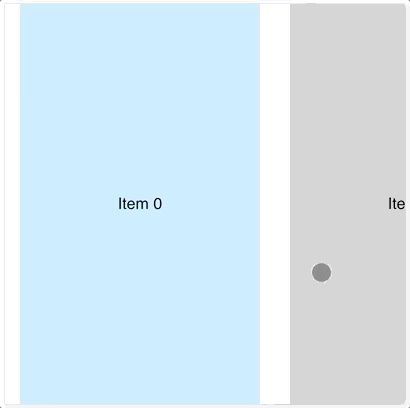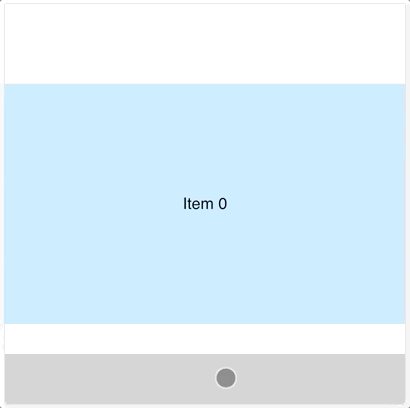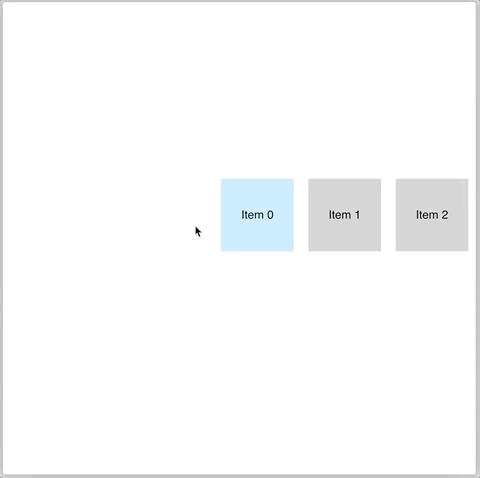A modern way to do a classic thing.
- Less than 3K gzipped size.
- Made 100% in React, no porting.
- No dependencies.
- Typescript ready.
- Using it in production.
- Using native browser snap option.
- No magic, you get the control thanks to the hooks.
npm install --save react-snaplist-carouselimport {
SnapList,
SnapItem,
useVisibleElements,
useScroll,
} from 'react-snaplist-carousel';import * as React from 'react';
import { SnapList, SnapItem } from 'react-snaplist-carousel';
const MyItem = ({ children }) => (
<div style={{ width: '70vw', height: 200, background: '#cccccc' }}>
{children}
</div>
);
export const App = () => (
<SnapList>
<SnapItem margin={{ left: '15px', right: '15px' }} snapAlign="center">
<MyItem>Item 0</MyItem>
</SnapItem>
<SnapItem margin={{ left: '15px', right: '15px' }} snapAlign="center">
<MyItem>Item 1</MyItem>
</SnapItem>
<SnapItem margin={{ left: '15px', right: '15px' }} snapAlign="center">
<MyItem>Item 2</MyItem>
</SnapItem>
<SnapItem margin={{ left: '15px', right: '15px' }} snapAlign="center">
<MyItem>Item 3</MyItem>
</SnapItem>
<SnapItem margin={{ left: '15px', right: '15px' }} snapAlign="center">
<MyItem>Item 4</MyItem>
</SnapItem>
</SnapList>
);import * as React from 'react';
import { SnapList, SnapItem } from 'react-snaplist-carousel';
const MyItem = React.forwardRef(({ children, ...props }, ref) => (
<div
style={{ width: '70vw', height: 200, background: '#cccccc' }}
ref={ref}
{...props}
>
{children}
</div>
));
export const App = () => {
const snapList = useRef(null);
const lastSnapItem = useRef(null);
const goToSnapItem = useScroll({ ref: snapList });
return (
<SnapList
ref={snapList}
tabIndex={0} // so it can receive focus and can be scrolled with keyboard
role="region" // context for screen readers
aria-label="my awesome snaplist" // for screen readers to read out loud on focus
>
<SnapItem margin={{ left: '15px', right: '15px' }} snapAlign="center">
<MyItem>Item 0</MyItem>
<button
onClick={() => {
goToSnapItem(4);
lastSnapItem.current?.focus();
}}
>
go to last item
</button>
</SnapItem>
<SnapItem margin={{ left: '15px', right: '15px' }} snapAlign="center">
<MyItem>Item 1</MyItem>
</SnapItem>
<SnapItem margin={{ left: '15px', right: '15px' }} snapAlign="center">
<MyItem>Item 2</MyItem>
</SnapItem>
<SnapItem margin={{ left: '15px', right: '15px' }} snapAlign="center">
<MyItem>Item 3</MyItem>
</SnapItem>
<SnapItem margin={{ left: '15px', right: '15px' }} snapAlign="center">
<MyItem ref={lastSnapItem} tabIndex={-1}>
Item 4
</MyItem>
</SnapItem>
</SnapList>
);
};import React, { useRef } from 'react';
import {
SnapList,
SnapItem,
useVisibleElements,
useScroll,
useDragToScroll,
isTouchDevice,
} from 'react-snaplist-carousel';
const MyItem = ({ onClick, children, visible }) => (
<div
style={{
width: '60vw',
height: 200,
background: visible ? '#bce6fe' : '#cccccc',
cursor: visible ? 'default' : 'pointer',
}}
onClick={onClick}
>
{children}
</div>
);
export const App = () => {
const snapList = useRef(null);
const visible = useVisibleElements(
{ debounce: 10, ref: snapList },
([element]) => element,
);
const goToSnapItem = useScroll({ ref: snapList });
const { isDragging } = useDragToScroll({ ref: snapList });
return (
<SnapList ref={snapList}>
<SnapItem margin={{ left: '20vw', right: '15px' }} snapAlign="center">
<MyItem onClick={() => goToSnapItem(0)} visible={visible === 0}>
Item 0
</MyItem>
</SnapItem>
<SnapItem margin={{ left: '15px', right: '15px' }} snapAlign="center">
<MyItem onClick={() => goToSnapItem(1)} visible={visible === 1}>
Item 1
</MyItem>
</SnapItem>
<SnapItem margin={{ left: '15px', right: '15px' }} snapAlign="center">
<MyItem onClick={() => goToSnapItem(2)} visible={visible === 2}>
Item 2
</MyItem>
</SnapItem>
<SnapItem margin={{ left: '15px', right: '15px' }} snapAlign="center">
<MyItem onClick={() => goToSnapItem(3)} visible={visible === 3}>
Item 3
</MyItem>
</SnapItem>
<SnapItem margin={{ left: '15px', right: '20vw' }} snapAlign="center">
<MyItem onClick={() => goToSnapItem(4)} visible={visible === 4}>
Item 4
</MyItem>
</SnapItem>
</SnapList>
);
};direction{ horizontal | vertical }: Scroll direction. *disableScroll{ boolean | undefined }: Disable the native scroll on swipe or mouse wheel.width{ string | undefined }: Width CSS propertyheight{ string | undefined }: Height CSS propertyscrollPadding{ { top?: string; right?: string; bottom?: string; left?: string; } | undefined }: Use this to configure the space to see from the previous/next hidden element. See scroll-padding for more informationhideScrollbar{ boolean }. Optional (default true): Hide/show scrollbars.ref{ React.RefObject<HTMLDivElement> | undefined }: The React.ref to the element required by the hooks.className{ string | undefined }: 🚑Please, use this only in case of emergency. It allows you to add/overwrite/extend all the CSS properties. If you need this, please consider opening an issue or contribute with a PR to cover your use case.
* Required fields
snapAlign{ start | center | end | none }: The box’s snap position when the scroll stops. See scroll-snap-align for more information *disableScroll{ boolean | undefined }: Avoid the scroll to "pass over" possible snap positions. See scroll-snap-stop for more informationwidth{ string | undefined }: Width CSS propertyheight{ string | undefined }: Height CSS propertymargin{ { top?: string; right?: string; bottom?: string; left?: string; } | undefined }: The margin is used to set the separation between the items. You can use different margin for the first and last item to get better results.className{ string | undefined }: 🚑Please, use this only in case of emergency. It allows you to add/overwrite/extend all the CSS properties. If you need this, please consider opening an issue or contribute with a PR to cover your use case.
* Required fields
const snapList = useRef(null);
const goToElement = useScroll({ ref: snapList });
return (
<SnapList ref={snapList}>
<SnapItem snapAlign="left">
<div onClick={() => goTo(0)}>Item 0</div>
</SnapItem>
<SnapItem snapAlign="left">
<div onClick={() => goTo(1)}>Item 1</div>
</SnapItem>
</SnapList>
);Response
- A function
(element:number, options?: { animationEnabled: boolean}) => voidto scroll to the element. The animationEnabled is true by default. It can be use to scroll to a component when mounting it.
Arguments
ref: { React.RefObject<HTMLDivElement> } *
* Required fields
const snapList = useRef(null);
const selected = useVisibleElements(
{ ref: snapList, debounce: 10 },
elements => elements[0],
);
const goToElement = useScroll({ ref: snapList });
React.useEffect(() => {
// scroll instantly on component did mount
goToElement(1, { animationEnabled: false });
}, []);
return (
<SnapList ref={snapList}>
<SnapItem snapAlign="left">
<div
onClick={() => goToElement(0)}
style={{
backgroundColor: selected === 0 ? 'papayawhip' : null,
}}
>
Item 0
</div>
</SnapItem>
<SnapItem snapAlign="left">
<div
onClick={() => goToElement(1)}
style={{
backgroundColor: selected === 1 ? 'papayawhip' : null,
}}
>
Item 1
</div>
</SnapItem>
</SnapList>
);Arguments
ref: { React.RefObject<HTMLDivElement> } *debounce: { number }. Optional (default 10). The time that the scroll is stopped before firing the visible elements check.selectorFunction: { (element:number[], elementInCenter: number | null) => any }. This selector gets an array of the visible elements as an argument and the return value will be returned by the useVisibleElements. Use this function to add some logic like select only the first one, calculate if there hidden elements before or later, etc... *
* Required fields
Tip
Use many times useVisibleElements hook with different debounce values for different purposes. For instance with a SnapList to select one option, one with debounce 10 for the slider dots animation or the selected option background and another one with debounce 100 to fire a select sideEffect.
Thanks @danieljb for the contribution
const snapList = useRef(null);
const selected = useVisibleElements(
{ ref: snapList, debounce: 10 },
elements => elements[0],
);
const { isDragging } = useDragToScroll({ ref: snapList, disable: false });
return (
<>
<p>{isDragging ? 'Dragging' : 'No dragging'}</p>
<SnapList ref={snapList}>
<SnapItem snapAlign="left">
<div
onClick={() => goToElement(0)}
style={{
backgroundColor: selected === 0 ? 'papayawhip' : null,
}}
>
Item 0
</div>
</SnapItem>
<SnapItem snapAlign="left">
<div
onClick={() => goToElement(1)}
style={{
backgroundColor: selected === 1 ? 'papayawhip' : null,
}}
>
Item 1
</div>
</SnapItem>
</SnapList>
</p>
);Response
isDragging: {boolean}.- disable: A function
() => voidto disable the dragToScroll feature. - enable: A function
() => voidto enable the dragToScroll feature.
Arguments
ref: { React.RefObject<HTMLDivElement> } *disable: { booleal }. Optional (default false). The hook will be auto-disabled on touch devices but you can force it using this option.
* Required fields
This an internal util function used by useDragToScroll that can be useful for you. You can use it to modify your UI depending on the device. For example, you can show next/previous arrows only on no touch devices.
- You can give a star to the project to help with the reputation
- You can share it with your colleagues.
- You can fork the repository and make your PR contribution.
- You can explore using IntersectionObserver for the useVisible hook.
- You can explore with better scrollTo polyfills.
- You can create usefull extra elements like Dots, Thumbnails, Progress or Arrows.
- You can create a new demo example, sky is the limit!
- Yes, you can.
- Fix decimal pixel problems
- Breakchange useDragToScroll is returning
{ isDragging }instead of the boolean. https://github.com/luispuig/react-snaplist-carousel/commit/a2d23d6b804dcab1da9520db8edc746c6837f23e#diff-e3457effa5fa347d185fdd0d08ba3209R173 - Version
4.1.0. Fix support for macOS Big Sur - Version
4.2.0. Add useScroll / goTo / animationEnabled option. Usefull to scroll on component mount. - Version
4.3.0.- Removed
event.preventDefault()formmouseDownso focus event can be propagated up in the DOM tree. <SnapList>now accept all theHTMLDivElementproperties.- New className attached so it is easier to target it through CSS:
<SnapList>has a.snaplist.<SnapItem>has a.snapitem.
- Removed
- Added useDragToScroll
- Added util isTouchDevice
- Improved useScroll. Now uses the scrollPading to calculate the position of the elements.
- Breakchange the SnapItem elements now uses margin in favor of padding. The browser native behavior works better works better.
MIT © luispuig



